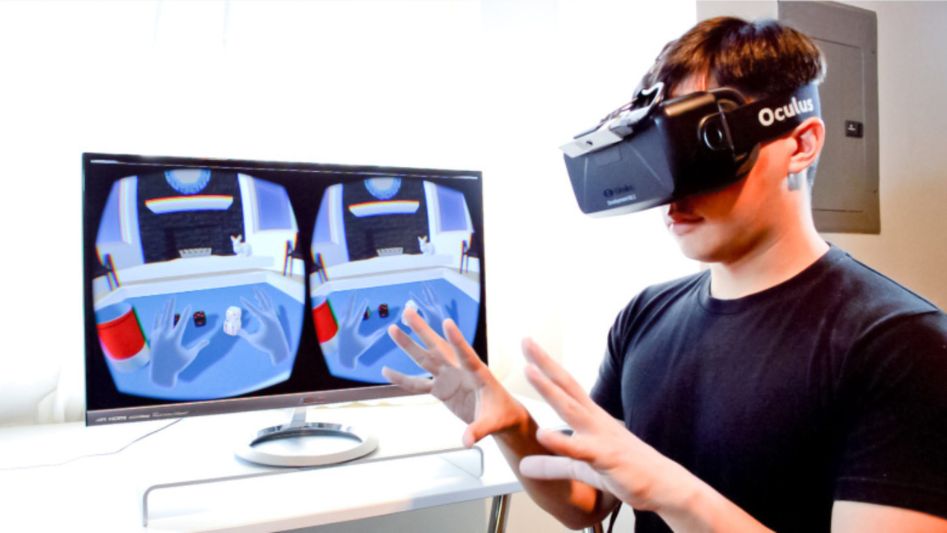In the realm of technology, two terms that have gained significant prominence over the past decade are Augmented Reality (AR) and Virtual Reality (VR). While both AR and VR offer immersive digital experiences, they are distinct technologies with unique applications and characteristics. In this article, we will delve into the world of AR and VR, exploring their differences, applications, and potential impact on various industries.
Table of Contents:
We invite you to read: “VIRTUAL REALITY TAKES CENTER STAGE: HOW VR IS REVOLUTIONIZING INDUSTRIES FROM ENTERTAINMENT TO HEALTHCARE”

Defining Augmented Reality (AR)
Augmented Reality, often abbreviated as AR, is a technology that overlays digital information, such as images, videos, or 3D models, onto the real world. Unlike VR, AR does not seek to create an entirely virtual environment; instead, it enhances the user’s perception of the physical world by adding digital elements to it. AR technology typically relies on devices like smartphones, tablets, smart glasses, or headsets equipped with cameras and sensors to blend the real and virtual worlds seamlessly.
Key Characteristics of Augmented Reality
- Real-world Integration: AR enhances the user’s real-world environment by superimposing digital content onto it, making it an ideal tool for enhancing daily tasks and activities.
- Interactive: AR applications often allow users to interact with virtual objects in their real environment. For example, users can place virtual furniture in their living room or play AR-based games that require physical movement.
- Examples: Popular AR applications include Snapchat filters, Pokémon GO, and navigation apps like Google Maps, which provide real-time directions and information overlaid on the camera view.
Understanding Virtual Reality (VR)
Virtual Reality, or VR, is a technology that immerses users in a completely digital and computer-generated environment. Unlike AR, which supplements the real world, VR transports users to a wholly virtual realm, often through the use of headsets or goggles that cover their field of vision. VR provides users with a sense of presence within this artificial environment, allowing them to interact with it as if it were real.
Key Characteristics of Virtual Reality
- Complete Immersion: VR aims to create a fully immersive experience by blocking out the physical world and replacing it with a simulated one, often with 360-degree visuals and spatial audio.
- Isolation: Users wearing VR headsets are typically isolated from their physical surroundings, which can be a pro or con depending on the intended application.
- Examples: VR is commonly used in gaming, simulations (such as flight or medical simulations), and even therapeutic applications, such as exposure therapy for anxiety disorders.
We invite you to read: “FROM FICTION TO REALITY: HOW AI IS RESHAPING OUR DAILY LIVES”

Differences Between AR and VR
Now that we have a clear understanding of both AR and VR, let’s highlight some of the key differences between these two technologies:
1. Interaction with the Real World
- AR: Augmented Reality enhances the real world by adding digital elements to it. Users can still see and interact with their physical environment while engaging with digital content.
- VR: Virtual Reality isolates users from the real world, replacing it entirely with a computer-generated environment. Users typically cannot see or interact with their physical surroundings when using VR.
2. Use Cases
- AR: AR finds applications in a wide range of industries, from gaming and entertainment to healthcare, education, and navigation. It enhances real-world experiences and provides information in context.
- VR: VR is primarily used in gaming and simulations but also has applications in training and therapy. It offers a complete escape from the real world into a virtual one.
3. Hardware Requirements
- AR: AR can be experienced on a variety of devices, from smartphones and tablets to dedicated AR glasses. Many people already own the necessary hardware to use AR applications.
- VR: VR typically requires specialized headsets or goggles, which can be expensive and require a more substantial investment.
4. Level of Immersion
- AR: While AR can provide immersive experiences, it always maintains a connection to the real world, allowing users to stay aware of their surroundings.
- VR: VR offers a higher level of immersion by completely replacing the real world with a virtual environment, often with a more intense sensory experience.
The Future of AR and VR
Both Augmented Reality and Virtual Reality have tremendous potential, and their development continues to evolve. Here are some glimpses into the future of these technologies:
- AR: AR is likely to become more integrated into our daily lives, with applications ranging from advanced navigation systems and interactive learning tools to improved healthcare solutions. As AR hardware becomes more accessible and user-friendly, we can expect to see its widespread adoption.
- VR: Virtual Reality is expected to continue to excel in gaming, offering increasingly immersive experiences. Additionally, VR may revolutionize remote work and collaboration by creating virtual meeting spaces that feel almost as natural as face-to-face interactions.
We invite you to read: “GAMING TECHNOLOGY: WHERE ENTERTAINMENT MEETS CUTTING-EDGE INNOVATION”

Conclusion
While Augmented Reality and Virtual Reality are often mentioned in the same breath, they are distinct technologies with unique features and applications. AR enhances the real world with digital elements, making it a versatile tool for a wide range of industries. VR, on the other hand, immerses users in entirely virtual environments, providing unparalleled experiences in gaming and simulations. As both technologies continue to advance, they are poised to reshape the way we interact with the digital and physical worlds, offering new possibilities for entertainment, education, healthcare, and more.
FAQs
What is Augmented Reality (AR)?
Augmented Reality is a technology that overlays digital content, such as images and 3D models, onto the real world, enhancing our perception of reality.
What is Virtual Reality (VR)?
Virtual Reality is a technology that immerses users in entirely computer-generated environments, providing a sense of presence within those digital worlds.
How does AR differ from VR?
AR enhances the real world by adding digital elements, while VR replaces the real world with a fully immersive virtual environment.
Where is AR used?
AR has applications in gaming, navigation, healthcare, education, and more, enhancing real-world experiences.
Where is VR commonly used?
VR is primarily used in gaming and simulations but also finds applications in training and therapy.
You May Also Like
- EMERGING TECHNOLOGIES IN HEALTHCARE: IMPROVING PATIENT CARE
- THE IMPACT OF 5G TECHNOLOGY: FASTER SPEEDS, ENHANCED CONNECTIVITY
- THE FUTURE OF TECHNOLOGY: 10 INNOVATIONS THAT WILL TRANSFORM OUR LIVES
- TRANSFORMING HEALTHCARE: HOW ROBOTS ARE SAVING LIVES
- THE FUTURE OF SOFTWARE DEVELOPMENT: TRENDS TO WATCH


Recent Comments